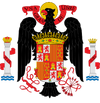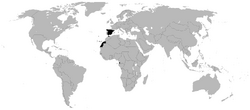The Spanish State refers to a period of Spanish history between 1939 and 1975 when Spain was under the authoritarian dictatorship of Francisco Franco.
The regime emerged from the victory in the Spanish Civil War of the rebel Nacionales coalition led by General Franco. Besides the internal support, Franco's rebellion had been backed from abroad by Fascist Italy and Imperial Germany, while the Second Spanish Republic was increasingly backed by Communist Russia.
After winning the Spanish Civil War, the Nacionales had established a single party authoritarian state under the undisputed leadership of Franco. World War II started shortly afterwards, and though Spain was officially neutral, it did send a special Division of troops to Russia to aid the Germans, and its pro-Axis stance led to it being isolated after the collapse of the Axis powers.
Spain was declared a monarchy in 1947, but no king was designated; Franco reserved for himself the right to name the person to be king, and deliberately delayed the selection due to political considerations. The selection finally came in 1969, with the designation of Juan Carlos de Borbón as Franco's official successor.
With the death of Franco on November 20, 1975, Juan Carlos became the absolute King of Spain. He immediately began the process of a transition to democracy, ending with Spain becoming a constitutional monarchy articulated by a parliamentary democracy.
History[]
Establishment[]
The Nationalist senior generals held an informal meeting in September 1936, where they elected Francisco Franco as leader of the Nationalists, with the rank of Generalísimo (sometimes written in English as Generalissimo, after the Fascist Italian fashion). He was originally supposed to be only commander-in-chief, but after the death of General Emilio Mola (the initial leader of the movement) became head of state as well with nearly unlimited and absolute powers.
This provisional government ruled over the territories controlled by the Nationalists during the Civil War. Its main political action during the war was the consolidation of the heterogeneous political forces that joined the rebellion into a single party, the authoritarian Falange Española Tradicionalista y de las JON.



